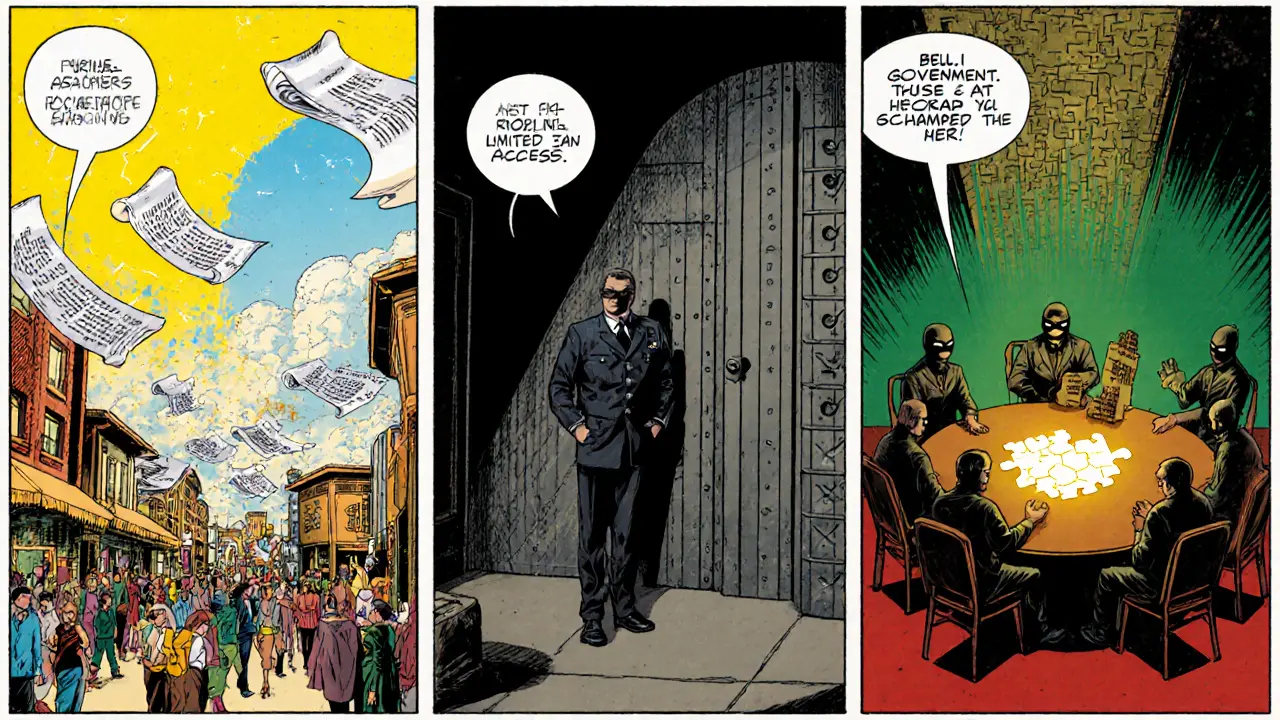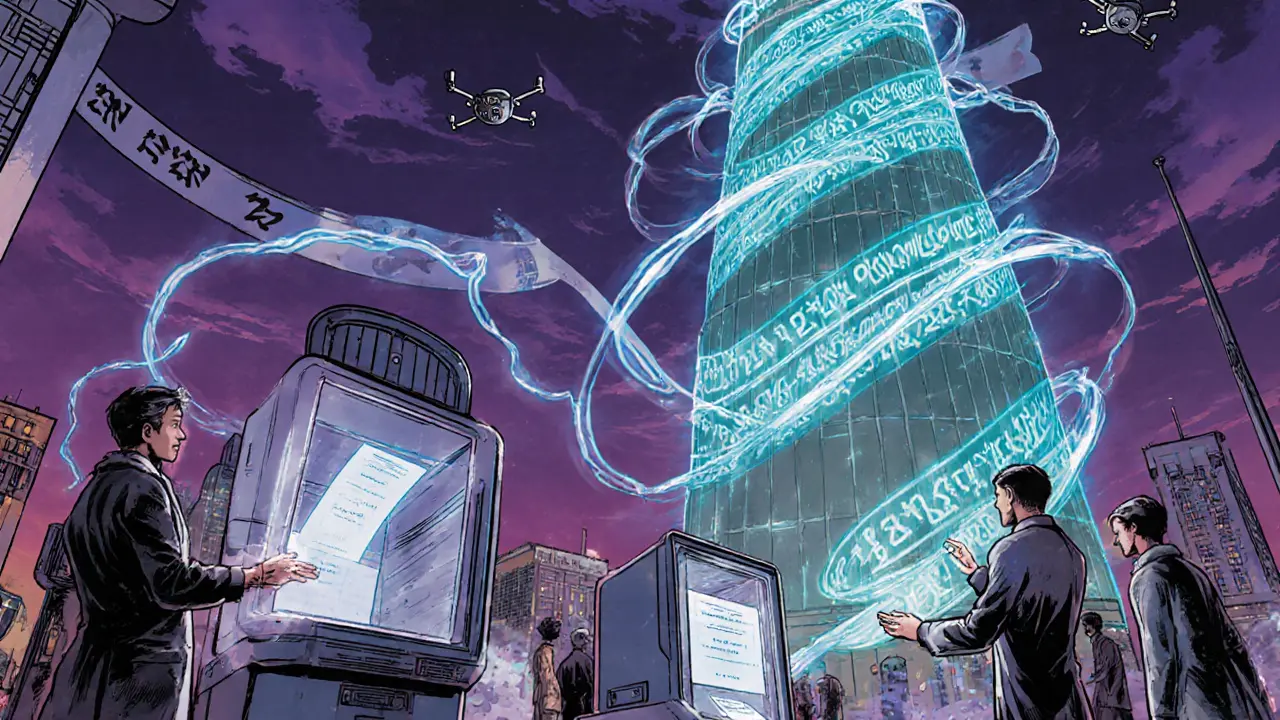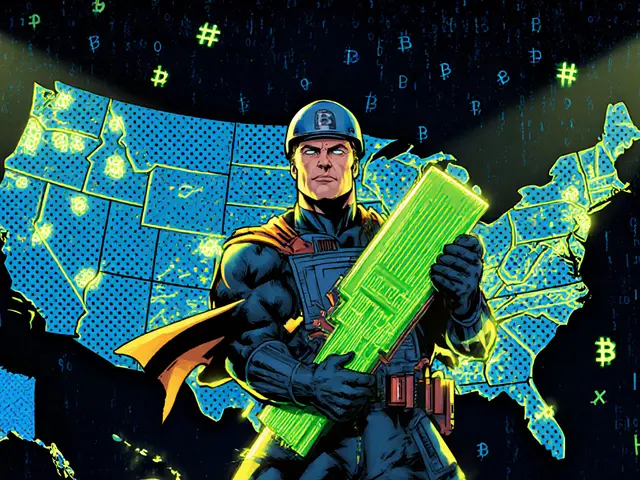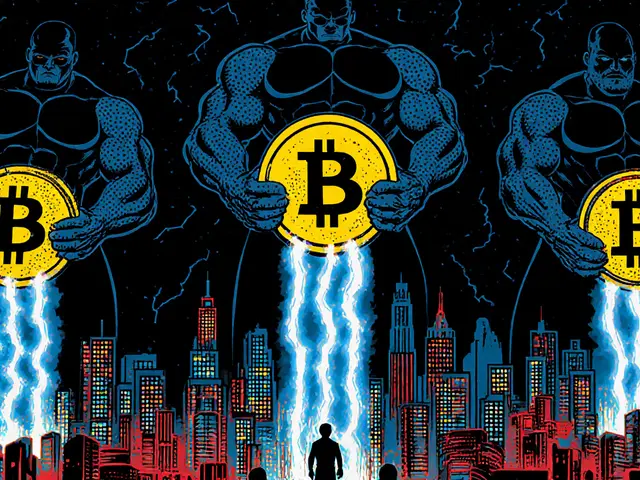
Blockchain Voting System Comparison Tool
This tool helps you understand how different blockchain architectures suit various voting needs. Select a scenario to see which blockchain type best fits your requirements.
Public Blockchain
- Transparency: Full access to ledger
- Control: Decentralized governance
- Best For: Open elections with public trust
- Drawbacks: Lower scalability, complex compliance
Private Blockchain
- Transparency: Limited access
- Control: Centralized governance
- Best For: Controlled environments
- Drawbacks: Single point of failure
Consortium Blockchain
- Transparency: Partial access
- Control: Shared governance
- Best For: Multi-entity collaboration
- Drawbacks: Complex coordination
When people talk about blockchain voting systems - a type of electoral platform that records each ballot as a transaction on a distributed ledger, the first thing that comes to mind is a mix of crypto‑tech and democracy. In practice, the idea is simple: replace paper or isolated electronic terminals with a network where every vote is encrypted, time‑stamped, and linked forever to the previous one. The result is a tally you can audit without ever revealing who chose what.
TL;DR
- Blockchain voting stores each ballot as an immutable transaction on a distributed ledger.
- Public‑key cryptography, zero‑knowledge proofs, and smart contracts keep votes private yet verifiable.
- Public, private, and consortium blockchains each offer a different balance of transparency and control.
- Real‑world pilots - Voatz, Follow My Vote, Votem - show both promise and practical hurdles.
- Key checklist: define requirements, pick a blockchain type, design UI, implement strong authentication, test rigorously.
How a Blockchain Vote Is Recorded
The core flow mirrors any cryptocurrency transaction, but with extra privacy layers. First, a voter registers and receives a public key that uniquely identifies their digital wallet. When they select a candidate, the choice is encrypted using homomorphic encryption, which lets the system add up votes without ever decrypting individual selections.
A smart contract then creates a transaction: the encrypted ballot, a timestamp, and a cryptographic hash linking it to the previous block. Once the block is validated by the network’s consensus algorithm, the vote becomes permanent - no admin can edit or erase it.
To prove their vote was counted, the voter receives a cryptographic receipt (often a zero‑knowledge proof). The receipt can be posted publicly; anyone can verify the proof matches the blockchain entry without learning the actual choice.
Key Cryptographic Building Blocks
Understanding the privacy guarantees requires a glance at the math:
- Public‑key cryptography - each voter holds a private key that signs their ballot, while the public key lets the network verify authenticity without exposing the private key.
- Zero‑knowledge proofs - enable voters to demonstrate a valid vote was cast without revealing the vote’s content.
- Homomorphic encryption - allows tallying of encrypted votes, keeping individual selections hidden until the final decryption phase.
- Ring signatures - mask the signer among a group, adding another layer of anonymity.
These techniques work together to satisfy two opposing requirements: voter privacy and election transparency.
Choosing the Right Blockchain Architecture
Not every blockchain fits a national election. The three main models are:
| Feature | Public Blockchain | Private Blockchain | Consortium Blockchain |
|---|---|---|---|
| Transparency | Full - anyone can read the ledger | Limited - only authorized nodes | Partial - pre‑approved participants |
| Control | Decentralized, no single authority | Centralized governance | Shared governance among selected entities |
| Scalability | Often lower, requires Layer2 solutions | Higher - can fine‑tune performance | Balanced - custom consensus can be optimized |
| Regulatory Fit | >Harder to meet data‑privacy laws | Easier to comply with local regulations | Designed for inter‑governmental use |
For a city council election, a private chain may be sufficient. A nationwide presidential vote might lean toward a consortium model, letting multiple electoral bodies share validation while keeping the ledger closed to the public.

Real‑World Pilots You Can Learn From
Three companies have run live pilots that illustrate different design choices.
- Voatz - used a mobile app for overseas military voters in West Virginia (2018). Voters validated identity via driver’s‑license data, received a token, and then transferred that token to the candidate’s address on a public‑key ledger.
- Follow My Vote - combined webcam facial verification with a private blockchain. Voters could change their selections up to the deadline; the system kept an immutable audit trail while offering real‑time result dashboards.
- Votem - built the CastIron platform on a permissioned consortium chain. It handled registration, ballot pre‑marking, and remote voting for several US states, emphasizing enterprise‑grade key management and threshold decryption.
All three report higher voter confidence, but they also faced hiccups: app crashes under load, steep learning curves for non‑tech‑savvy voters, and lingering legal uncertainty in many jurisdictions.
Benefits Over Traditional Systems
The most touted advantage is immutability: once a vote lands on the chain, no one can alter it without breaking the cryptographic hash chain, which would be instantly visible to observers.
Second, real‑time verification lets each voter confirm their ballot is present and unchanged, while third‑party auditors can watch the tally grow without accessing any private data.
Third, the system can dramatically cut costs for absentee or overseas voting because the same digital infrastructure replaces physical drop boxes and paper transport.
Challenges and Why Full Adoption Isn’t Here Yet
Technical complexity remains the biggest barrier. Implementing secure key management, zero‑knowledge proofs, and user‑friendly interfaces takes specialized talent.
Scalability is another concern. A national election with millions of voters can overload a naïve blockchain; most pilots rely on Layer2 solutions (state channels or roll‑ups) to batch transactions before anchoring them on the main chain.
Lastly, regulatory frameworks lag. Many countries lack clear legal language that recognises a blockchain ledger as an official vote record, leaving election officials hesitant to certify results.
Step‑by‑Step Checklist for Running a Blockchain Election
- Define scope: number of voters, ballot complexity, required audit level.
- Select blockchain type (public, private, consortium) based on transparency vs. control trade‑offs.
- Design voter registration module - integrate government ID checks, assign public/private key pairs.
- Develop smart contracts for ballot casting, encryption, and automatic tallying.
- Implement authentication - multi‑factor, biometric or webcam verification, and secure key storage.
- Build UI/UX - mobile‑first design with clear instructions for receipt verification.
- Run security testing - penetration tests, formal verification of smart contracts, and user‑acceptance trials.
- Deploy pilot - start with a low‑stakes election (e.g., university board) to gather data.
- Monitor & maintain - real‑time node health checks, anomaly detection, and post‑election audits.
Future Outlook
Industry analysts expect hybrid solutions to dominate the next five years: traditional paper or DRE machines for in‑person voting paired with blockchain‑backed remote ballots. Advances in zero‑knowledge proof algorithms (like zk‑STARKs) promise even lighter verification without heavy computation, while Layer2 scaling will let blockchains handle tens of millions of votes per second.
Regulators are drafting standards - the European Union’s e‑Voting framework already mentions “cryptographically verifiable” processes, a direct nod to blockchain technology. Once legal certainty arrives, larger jurisdictions will likely move from pilots to full‑scale deployments.

Frequently Asked Questions
What makes a blockchain vote tamper‑proof?
Each vote is recorded as a transaction that includes a cryptographic hash of the previous block. Changing any vote would break that hash chain, which is instantly detectable by any node on the network.
Can a voter prove they voted without revealing their choice?
Yes. Using zero‑knowledge proofs or cryptographic receipts, a voter can submit a proof that their encrypted ballot was included in the ledger, while the actual candidate selection stays hidden until the final decryption phase.
Is blockchain voting accessible to people without smartphones?
Accessibility depends on the UI design. Some pilots offer web‑based portals that work on any device, while others provide dedicated kiosks. The key is to pair the technology with offline assistance for those who need it.
How does scalability work for a national election?
Most large‑scale projects use Layer2 solutions - such as roll‑ups or state channels - that bundle thousands of votes into a single on‑chain transaction, dramatically reducing load while preserving security.
What legal hurdles still exist?
Many jurisdictions lack statutes that recognize a blockchain ledger as an official record. Until laws are updated, election officials must run blockchain pilots alongside traditional methods to ensure results are legally binding.






There are 16 Comments
Linda Welch
The whole blockchain voting hype reads like a dystopian novel written by someone who never voted on paper and thinks that randomness equals security and that decentralization magically solves every bureaucratic nightmare it pretends to address while completely ignoring the reality that most voters can’t even manage a password manager let alone a private key that lives forever on a public ledger and somehow the industry believes that by sprinkling buzzwords like zero‑knowledge proofs and homomorphic encryption they can distract us from the fact that the underlying infrastructure is still fragile and susceptible to quantum attacks that are already being researched by nation‑states who might one day decide to rewrite election outcomes with a single line of code and don’t get me started on the massive energy consumption that some public blockchains demand as if we need to power the whole Internet just to verify a single ballot choice that could have been counted just as well with a paper ballot audited by humans who actually understand the process the way it works and not by a swarm of miners whose only job is to chase coins while pretending to be guardians of democracy the notion that a private blockchain can magically provide both privacy and immutability without a single point of failure is a paradox that only works in theory but collapses in practice when a single node is compromised or a developer embeds a backdoor that no one sees because the code is hidden behind proprietary walls and the promise of transparency becomes a joke when the only people who can read the ledger are the very authorities that are supposed to be held accountable which is why the whole conversation feels like a techno‑utopian sermon that never acknowledges the messy, human side of elections where trust is built over decades not in a few lines of Solidity you can write in a weekend and deploy to a testnet before anyone even reads the whitepaper the real issue isn’t whether blockchain can be made to work but whether society is ready to hand over the sacred act of voting to a system that most of us barely understand and that’s a problem no amount of cryptography can solve.
Kevin Fellows
Wow this is fascinating! I love how blockchain can bring new transparency to elections, seems like a great step forward.
meredith farmer
Honestly I think the whole thing is a massive cover‑up. The powers that be are already inserting hidden backdoors in the code and you’ll never see it because they control the consortium nodes. I’m not saying it’s impossible, but the risk is real and the public is being fooled. The narrative about security is just a smokescreen. It’s scary how quickly people accept it without questioning who benefits.
Peter Johansson
It’s understandable to feel uneasy - technology that changes how we vote touches on deep cultural values. From a philosophical angle, the idea of an immutable ledger can be seen as a collective memory, a shared truth that outlives any single authority. This could empower citizens if implemented with transparency and education 😊. At the same time, we must ensure that the system reflects diverse cultural contexts and respects local norms.
Alie Thompson
We have to consider the moral implications of entrusting a complex cryptographic system to a society that is already divided along partisan lines. The promise of immutability sounds appealing, yet the reality is that the very design of any blockchain requires governance decisions that can be influenced by powerful interests, and that creates a moral hazard. Moreover, the notion that anonymity and transparency can coexist without abuse is a flawed ethical premise, because absolute anonymity can protect malicious actors as well as protect the innocent. It is imperative that we develop a framework that upholds democratic values, ensures equitable access, and prevents the concentration of power in the hands of a technocratic elite. Only then can we claim any moral high ground in this debate.
Samuel Wilson
Indeed, a rigorous governance model is essential. The implementation should adhere to established legal standards, maintain auditability, and provide clear mechanisms for dispute resolution. Precision in design mitigates risks and builds public trust.
Rae Harris
Look, the whole blockchain voting stack is just another buzz‑tech funnel that the industry pushes to keep the venture capital money flowing. You keep hearing about zero‑knowledge proofs, but most of the implementation details are hidden behind NDA‑wrapped whitepapers that nobody outside the consortium can read. It’s a classic case of hype over substance, and the real question is: who really benefits?
Danny Locher
I hear you, but I think it’s worth experimenting in low‑stakes elections to see how people actually react. Simple pilots can give us data without risking major outcomes.
Emily Pelton
Absolutely, we need pilots, but let’s be clear, we shouldn’t just roll out a half‑baked system and hope for the best, because that would be reckless, and the community deserves a transparent rollout, with thorough testing, and clear communication, otherwise we risk undermining confidence, and that’s counterproductive, especially when we claim to protect democracy.
sandi khardani
The problem with these pilot projects is that they are often cherry‑picked to showcase success while ignoring the inevitable failures that arise when scaling to millions of voters, and the data collection is typically proprietary, making it impossible for independent researchers to validate claims, which perpetuates a cycle of unchecked optimism that ultimately harms the credibility of the entire voting reform movement, especially when the underlying cryptographic assumptions are not fully vetted against emerging threats, leaving the system vulnerable to subtle attack vectors that may not be apparent until after a critical election.
Donald Barrett
This is exactly why blockchain voting is a joke. Too many variables, too little accountability.
Christina Norberto
One must consider the ontological ramifications of delegating sovereign civic duties to algorithmic constructs whose provenance is often obfuscated by layers of abstraction; the epistemic trust placed in such mechanisms is predicated upon a presumed infallibility that history has repeatedly disproven, especially when considering the potential for clandestine manipulation by entities with vested interests, thereby necessitating a scrupulous examination of the legal and philosophical foundations upon which these systems are erected.
Fiona Chow
Right, because trusting a black‑box to count votes is obviously the most logical solution, isn’t it? Let’s just hope the algorithms don’t develop a sense of humor and start voting for themselves.
Rebecca Stowe
Well said! It’s great to keep the conversation friendly and forward‑looking.
Aditya Raj Gontia
The tech stack seems solid but the integration overhead is non‑trivial, especially when considering legacy systems compatibility and compliance requirements across jurisdictions.
Kailey Shelton
Interesting take.
Write a comment
Your email address will not be published. Required fields are marked *